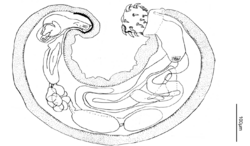Biology:Cement glands
From HandWiki
Short description: Small organs in thorny-headed worms
Cement glands are small organs found in Acanthocephala that are used to temporarily close the posterior end of the female after copulation.[1]
Cement glands are also mucus-secreting organs that can attach embryos or larvae to a solid substrate. These can be found in frogs such as those in the genus Xenopus,[2] fish such as the Mexican tetra,[3] and crustaceans.
References
- ↑ Bush, Albert O.; Fernández, Jacqueline C.; Esch, Gerald W.; Seed, J. Richard (2001). Parasitism : the diversity and ecology of animal parasites. Cambridge, UK New York, NY: Cambridge University Press. p. 203. ISBN 0-521-66278-8. OCLC 44131774.
- ↑ Sive, Hazel; Bradley, Leila (1996). "A sticky problem: The Xenopus cement gland as a paradigm for anteroposterior patterning". Developmental Dynamics 205 (3): 265–280. doi:10.1002/(SICI)1097-0177(199603)205:3<265::AID-AJA7>3.0.CO;2-G. PMID 8850563. https://anatomypubs.onlinelibrary.wiley.com/doi/epdf/10.1002/%28SICI%291097-0177%28199603%29205%3A3%3C265%3A%3AAID-AJA7%3E3.0.CO%3B2-G. Retrieved 29 September 2021.
- ↑ Pottin, Karen; Hyacinthe, Carole; Rétaux, Sylvie (October 5, 2010). "Conservation, development, and function of a cement gland-like structure in the fish Astyanax mexicanus". Proceedings of the National Academy of Sciences 107 (40): 17256–17261. doi:10.1073/pnas.1005035107. PMID 20855623. Bibcode: 2010PNAS..10717256P.
 |


